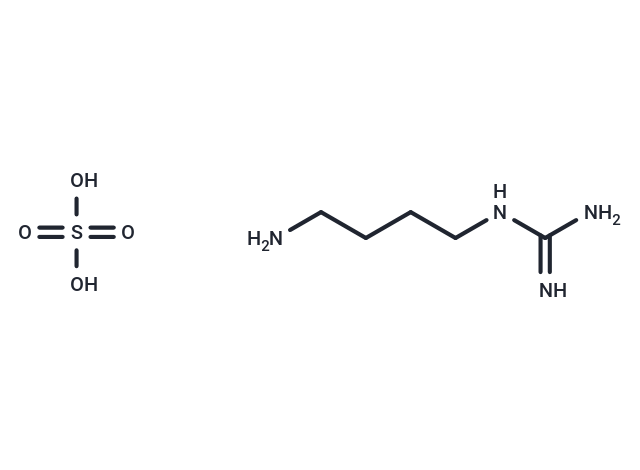Shopping Cart
- Remove All
 Your shopping cart is currently empty
Your shopping cart is currently empty

Agmatine sulfate (Agmatine sulfate salt) is a bioactive metabolite of the arginine amino acid. It exerts modulatory action at multiple molecular targets, such as neurotransmitter systems, ion channels and nitric oxide synthesis. It is an endogenous agonist at imidazoline receptor and a NO synthase inhibitor.

| Pack Size | Price | Availability | Quantity |
|---|---|---|---|
| 100 mg | $41 | In Stock | |
| 1 g | $66 | In Stock | |
| 1 mL x 10 mM (in H2O) | $64 | In Stock |
| Description | Agmatine sulfate (Agmatine sulfate salt) is a bioactive metabolite of the arginine amino acid. It exerts modulatory action at multiple molecular targets, such as neurotransmitter systems, ion channels and nitric oxide synthesis. It is an endogenous agonist at imidazoline receptor and a NO synthase inhibitor. |
| In vitro | Agmatine, locally synthesized, is an endogenous agonist at imidazoline receptors, a noncatecholamine ligand at alpha 2-adrenergic receptors and may act as a neurotransmitter[1]. Agmatine is synthesized in the brain, stored in synaptic vesicles in regionally selective neurons, accumulated by uptake, released by depolarization, and inactivated by agmatinase. Agmatine inhibits nitric oxide synthase and induces the release of some peptide hormones[2]. Agmatine, 4-(aminobutyl)guanidine, is produced by decarboxylation of L-arginine by the enzyme arginine decarboxylase. Agmatine is a competitive inhibitor of all NOS isoenzymes but not a NO precursor. Ki values are approximately 660 μM (NOS I), 220 μM (NOS II) and 7.5 mM (NOS III)[3]. Agmatine stimulates nitrite production three-fold above basal nitrite formation by endothelial cells. Agmatine displaces [3H]-idazoxan from endothelial cell membranes and is found to induce transients in the cytosolic calcium of endothelial cells. The transients could be downregulated by repeated exposure to agmatine but are not affected by pretreatment with norepinephrine[4]. |
| In vivo | Agmatine exhibits an antidepressant-like effect in the forced swimming test and the tail suspension test in mice (dose range 0.01-50 mg/kg, i.p.), with no alterations in ambulation in an open-field[5]. |
| Alias | Agmatine sulfate salt |
| Molecular Weight | 228.27 |
| Formula | C5H16N4O4S |
| Cas No. | 2482-00-0 |
| Smiles | OS(O)(=O)=O.NCCCCNC(N)=N |
| Relative Density. | no data available |
| Storage | Powder: -20°C for 3 years | In solvent: -80°C for 1 year | Shipping with blue ice. | ||||||||||||||||||||
| Solubility Information | DMSO: Insoluble H2O: 10 mM, Sonication is recommended. | ||||||||||||||||||||
Solution Preparation Table | |||||||||||||||||||||
H2O
| |||||||||||||||||||||

Copyright © 2015-2025 TargetMol Chemicals Inc. All Rights Reserved.